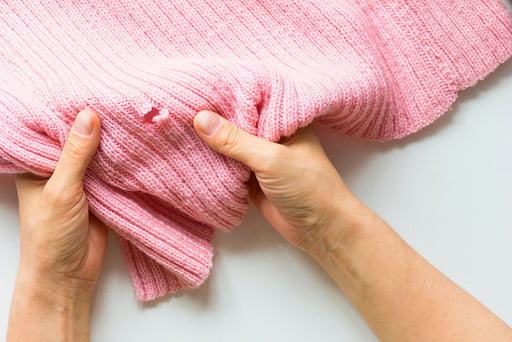Clothes Moths Facts, Figures & Statistics

Clothes Moths can be extremely destructive and frustrating to deal with. After all, when you have a well-stocked closet with gorgeous clothes made of cashmere, silk, fur, or other fine materials, the last thing you want is a Clothes Moth infestation! Knowing the different types of Clothes Moths, how to identify them, as well as other interesting facts, figures and statistics to do with moths will help you to manage your Clothes Moth problem.
Below, we will provide many moth facts and other interesting things to know about them. We will also go over what you can do to ensure that your treasured belongings are protected from these aggravating pests. That way, you can spend less time worrying about insects and more time deciding what to add to your fashion collection this season.
Understanding Clothes Moths: The Facts You Need To Know
As pests, Clothes Moths can easily decimate a range of fabrics, natural fibres, and other materials. In particular, they can destroy wool, silk, feathers, fur, leather, and felt. The moth larvae feed exclusively on animal fibres, keratin, and the fibrous proteins found in these materials.
Adult Clothes Moths do not feed on clothes. In fact, they don't feed at all. The sole purpose of an adult Clothes Moth is to find a mate and/or lay eggs. After mating, adult Clothes Moths lay anywhere from 30-60 eggs each. These eggs then hatch into the ‘clothes destroying larvae’ that you absolutely don't want in your closet.

Since these worm-like larvae can easily digest very coarse materials, they sometimes feed on more than just natural fibres. Occasionally, they feed on cotton or even synthetic fabrics. Although this is rare, when these materials are stained with food particles, blended with wool, or soiled by bodily oils, Clothes Moth Larvae will be attracted to them. Even very tough natural materials like sheepskin rugs, taxidermied animals, and furniture can be vulnerable.
The best way to prevent damage to your clothes and valuables from Clothes Moths is to preemptively protect your home. Stopping an infestation before it starts is the simplest and most effective method of Clothes Moth prevention. However, this isn't always possible. If you already have seen signs of damage or noticed moth-eaten fabrics, you can still rid yourself of an infestation. More on that later!
Facts About Clothes Moths
Clothes Moths can be hard to notice because they avoid light instead of flying toward it. These moths prefer dark, quiet places. Unlike larger, more colourful moths, Clothes Moths are relatively plain. They are usually beige, buff-brown, tan, or brownish-cream in colour. They have hairy, narrow wings that fold down the sides of the thorax. At only 1/2 inch in length, these pesky moths aren't particularly noteworthy and can easily go unnoticed.
In many cases, people mistake Clothes Moths for Pantry Moths. To tell the difference between a Clothes Moth or a Pantry Moth, just consider where it is in the home. If you find moth evidence in a pantry or in the kitchen, you probably have Pantry Moths. However, Pantry Moths prefer partially lit areas with plenty of airflow. In contrast, Clothes Moths like still, dark, quiet places. Clothes Moths can often be found in basements, attics, and of course, your closet.

Distinguishing Between Common Clothes Moth Species in the US
In North America, there are two main types of clothes moths. The first is the Webbing Clothes Moth and the second is the Casemaking Clothes Moth. The Webbing Clothes Moth (Tineola Bisselliella) has a uniform, buff beige colour. They have small reddish tufts of hair on the top of the head. Casemaking Clothes Moths (Tinea Pellionella) look very similar but have dark speckled patches or spots on the sides of their wings.
So which species is worse to deal with? Both species are pretty pesky. Either type of Clothes Moth can destroy your clothes when in their larval stage. If you see evidence of either kind of moth in your home, begin the eradication process right away.
How to Find and Remove Clothes Moth Infestations

Finding and eradicating Clothes Moth infestations will take a bit of detective work on your part.
Look Out for the Following Signs of an Infestation:
- Tiny, sticky tubes (larvae casings) on fabric and rugs or in the corners of a room/closet
- Irregular holes in your clothing
- Fur garments and accessories that shed excessively
- Moths flying around or crawling on items in your home
- Silky tunnels or furrows found near or in wool fabric and clothing
- Crust-like spots on rugs, draperies, and clothing
After finding evidence of these moths, you will want to thoroughly clean the area where the signs of an infestation are present. You can vacuum seal and freeze any clothing from the infested area in plastic bags which will kill off the Clothes Moth Larvae and eggs. Be sure to keep items in a freezer for at least 72 hours.
Now, use a moth killer to treat the affected area. At MothPrevention you have a range of effective and powerful Clothes Moth Killer Kits to suit the size of the area you are treating. You can also spray down the area with vinegar and wipe it clean. Then, vacuum everything thoroughly afterward, and be sure to empty your vacuum container outside or in a sealed bag.

Clothes Moth FAQs
Now let's answer a few more Clothes Moth frequently asked questions. That way, you'll be fully prepared to get rid of these pesky fashion-ruining pests for good.
What types of moths eat clothes?
Although there are many different types of moths, only a few types of moths that eat clothes can be found in North America. In the United States, the two types of Clothes Moths to watch out for are the Casemaking Clothes Moth and the Webbing Clothes Moth. Most other moth varieties leave your clothes alone.
How do I identify Clothes Moths?
To start implicating useful moth solutions, first identify whether you have clothes moths or something else. Clothes moths can be identified by their plain appearance and small size. They can also be identified by their behaviour. These moths are not attracted to light and usually try to hide in the quietest, darkest places of your home. They are beige in colour and have wings that fold on the sides and reddish hairs on the tops of their heads.
How many types of Clothes Moths are there?
Although there are thousands of species of moths in the world, in North America, there are only two main types of moths. These are the Webbing and the Casemaking clothes moth.
How to prevent Clothes Moths?
Using Clothes Moth Traps is the most effective method to catch the active adult male Clothes Moths and this will also help break the breeding cycle. Natural deterrents can be placed in drawers and closets; these include cedar chips or blocks and sachets filled with dried herbs such as lavender, bay, and thyme.
But be careful! Using Pheromone Clothes Moth Traps (attracting male flying clothes moths) will be fighting against your "natural moth repellents" trying to deter the flying moths if placed in close proximity. We recommend using clothes moth traps to monitor and detect the presence of moths with a greater potency, life and effectiveness than herbal sachets.
The best offense is a good defense!
How do you find a Clothes Moth nest?
Moths do not have nests in the true sense of the word. You may discover evidence of moth activity in the form of a cluster of casings and moth damage in certain parts of your home, but this is not a nest. They are drawn to dark corners and undisturbed places, such as closets, attics and basements.

About MothPrevention
MothPrevention® speak to customers every day about their clothes moth issues - clothes moths are a species that are ever increasing and that can cause significant damage to clothes, carpets and other home textiles.
To date, we’ve helped over 250,000 customers deal with their moth problems. We have developed professional grade solutions including proprietary pheromones and trap design engineered to the highest production standards.





